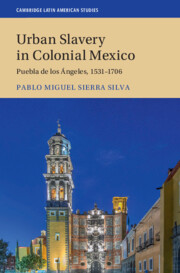Book contents
- Urban Slavery in Colonial Mexico
- Cambridge Latin American Studies
- Urban Slavery in Colonial Mexico
- Copyright page
- Dedication
- Contents
- Figures and Tables
- Acknowledgments
- Archival Abbreviations
- Introduction
- 1 Early Puebla and the Question of Labor, 1531–1570
- 2 Ambition and Agency in the Obraje
- 3 Captive Souls
- 4 The Puebla Slave Market, 1600–1700
- 5 Life in the Big City
- 6 The Other Market
- Epilogue
- Appendix A Bill of purchase for Arara captives on the Puebla slave market, 1615
- Appendix B Testament of Francisco Carmona, 1633
- Bibliography
- Index
- Other Books in the Series (continued from page iii)
- References
Bibliography
Published online by Cambridge University Press: 03 April 2018
- Urban Slavery in Colonial Mexico
- Cambridge Latin American Studies
- Urban Slavery in Colonial Mexico
- Copyright page
- Dedication
- Contents
- Figures and Tables
- Acknowledgments
- Archival Abbreviations
- Introduction
- 1 Early Puebla and the Question of Labor, 1531–1570
- 2 Ambition and Agency in the Obraje
- 3 Captive Souls
- 4 The Puebla Slave Market, 1600–1700
- 5 Life in the Big City
- 6 The Other Market
- Epilogue
- Appendix A Bill of purchase for Arara captives on the Puebla slave market, 1615
- Appendix B Testament of Francisco Carmona, 1633
- Bibliography
- Index
- Other Books in the Series (continued from page iii)
- References
- Type
- Chapter
- Information
- Urban Slavery in Colonial MexicoPuebla de los Ángeles, 1531–1706, pp. 211 - 222Publisher: Cambridge University PressPrint publication year: 2018



